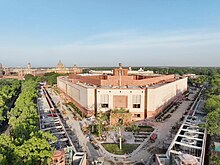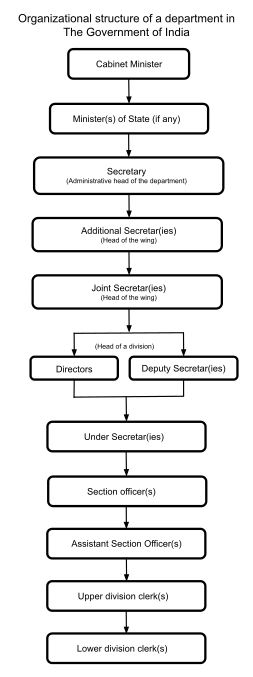A | B | C | D | E | F | G | H | CH | I | J | K | L | M | N | O | P | Q | R | S | T | U | V | W | X | Y | Z | 0 | 1 | 2 | 3 | 4 | 5 | 6 | 7 | 8 | 9
 Emblem of the Government of India | |
| Formation | 28 August 1833 |
|---|---|
| Current constitution | Indian Constitution of 1950 |
| Country | |
| Website | india |
| Legislative branch | |
| Legislature | Parliament |
| Meeting place | Parliament House |
| Executive branch | |
| Leader | President of India along with Union Council of Ministers headed by the Prime Minister of India |
| Headquarters | Central Secretariat |
| Departments | Union Council of Ministers, Union Government ministries of India |
| Judicial branch | |
| Court | Supreme Court of India |
| Chief Justice | Chief Justice of India |
| This article is part of a series on the |
| Politics of India |
|---|
 |
|
|
The Government of India constitutionally known as the Union Government and also called the Central Government, is the national authority of the Republic of India, a federal republic located in South Asia, consisting of 28 states and eight union territories.
The government, seated in New Delhi, has three primary branches: the legislative, the executive and the judiciary, whose powers are vested in a bicameral Parliament, a prime minister, and the Supreme Court respectively, with a president as head of state. Judicial appointments are made with negligible say from the executive or legislature.[citation needed]
Etymology and history
This section needs expansion. You can help by adding to it. (June 2022) |
The Government of India Act 1833, passed by the British parliament, is the first such act of law with the epithet "Government of India".[1]
Basic structure
The Government of India is modelled after the Westminster system.[2] The Union government is mainly composed of the executive, the legislature, and the judiciary, and powers are vested by the constitution in the prime minister, parliament, and the supreme court, respectively. The president of India is the head of state and the commander-in-chief of the Indian Armed Forces, while the elected prime minister acts as the head of the executive and is responsible for running the Union government.[3] The parliament is bicameral in nature, with the Lok Sabha being the lower house, and the Rajya Sabha the upper house. The judiciary systematically contains an apex supreme court, 25 high courts, and several district courts, all inferior to the supreme court.[4]
The basic civil and criminal laws governing the citizens of India are set down in major parliamentary legislation, such as the civil procedure code, the penal code, and the criminal procedure code.[5] Similar to the Union government, individual state governments each consist of executive, legislative and judiciary branches. The legal system as applicable to the Union and individual state governments is based on the English common and Statutory Law.[6] The full name of the country is the Republic of India. India and Bharat are equally official short names for the Republic of India in the Constitution,[7] and both names appears on legal banknotes, in treaties and in legal cases. The terms "Union government", "central government" and "bhārat sarkār" are often used officially and unofficially to refer to the government of India.[citation needed] The term New Delhi is commonly used as a metonym for the Union government,[8] as the seat of the central government is in New Delhi.
Legislature

The powers of the legislature in India are exercised by the Parliament, a bicameral legislature consisting of the Rajya Sabha and the Lok Sabha. Of the two houses of parliament, the Rajya Sabha (or the 'Council of States') is considered to be the upper house and consists of members appointed by the president and elected by the state and territorial legislatures. The Lok Sabha (or the 'House of the People') is considered the lower house.[9]
The parliament does not have complete control and sovereignty, as its laws are subject to judicial review by the Supreme Court.[10] However, it does exercise some control over the executive. The members of the Council of Ministers, including the prime minister, are either chosen from parliament or elected there within six months of assuming office.[11] The council as a whole is responsible to the Lok Sabha.[12] The Lok Sabha is a temporary house and can be dissolved only when the party in power loses the support of the majority of the house. The Rajya Sabha is a permanent house and can never be dissolved. The members of the Rajya Sabha are elected for a six-year term.[13]
Executive
The executive of government is the one that has sole authority and responsibility for the daily administration of the state bureaucracy. The division of power into separate branches of government is central to the republican idea of the separation of powers.[14]
President
The executive power is vested mainly in the President of India, as per Article 53(1) of the constitution. The president has all constitutional powers and exercises them directly or through subordinate officers as per the aforesaid Article 53(1). The president is to act following aid and advice tendered by the Prime Minister, who leads the Council of Ministers as described in Article 74 of the Constitution.
The council of ministers remains in power during the 'pleasure' of the president. However, in practice, the council of ministers must retain the support of the Lok Sabha. If a president were to dismiss the council of ministers on his or her initiative, it might trigger a constitutional crisis. Thus, in practice, the Council of Ministers cannot be dismissed as long as it holds the support of a majority in the Lok Sabha.
The President is responsible for appointing many high officials in India. These high officials include the governors of the 28 states; the chief justice; other judges of the supreme court and high courts on the advice of other judges; the attorney general; the comptroller and auditor general; the chief election commissioner and other election commissioners; the chairman and members of the Union Public Service Commission; the officers of the All India Services (IAS, IFoS and IPS) and Central Civil Services in group 'A'; and the ambassadors and high commissioners to other countries on the recommendations of the Council of Ministers.[15][16]
The President, as the head of state, also receives the credentials of ambassadors from other countries, while the prime minister, as head of government, receives credentials of high commissioners from other members of the Commonwealth, in line with historical tradition.
The President is the de jure commander-in-chief of the Indian Armed Forces.[17]
The President of India can grant a pardon to or reduce the sentence of a convicted person once, particularly in cases involving the punishment of death. The decisions involving pardoning and other rights by the president are independent of the opinion of the prime minister or the Lok Sabha majority. In most other cases, however, the president exercises his or her executive powers on the advice of the prime minister.[18] Presently, the President of India is Droupadi Murmu.
Vice president
The vice president is the second-highest constitutional position in India after the president. The vice president represents the nation in the absence of the president and takes charge as acting president in the incident of resignation impeachment or removal of the president. The vice president also has the legislative function of acting as the chairman of the Rajya Sabha.[19] The vice president is elected indirectly by members of an electoral college consisting of the members of both the houses of the parliament following the system of proportional representation employing the single transferable vote and the voting is by secret ballot conducted by the election commission.
Prime minister

The Prime Minister of India, as addressed in the Constitution of India, is the chief executive of the government and the leader of the majority party that holds a majority in the Lok Sabha. The prime minister leads the executive of the Government of India.
The prime minister is the senior member of the cabinet in the executive government in a parliamentary system. The prime minister selects and can dismiss other members of the cabinet; allocates posts to members within the Government; is the presiding member and chairman of the cabinet and is responsible for bringing a proposal of legislation. The resignation or death of the prime minister dissolves the cabinet.
The prime minister is appointed by the president to assist the latter in the administration of the affairs of the executive.
Cabinet, ministries and agencies

The Union Council of Ministers includes the prime minister, Cabinet Ministers and Ministers of State (MoS).[20] Each minister must be a member of one of the houses of the parliament. The cabinet is headed by the prime minister, and is advised by the cabinet secretary, who also acts as the head of the Indian Administrative Service and other civil services. Other members of the council are either union cabinet ministers, who are heads of various ministries; or ministers of state, who are junior members who report directly to one of the cabinet ministers, often overseeing a specific aspect of government; or ministers of state (independent charges), who do not report to a cabinet minister. As per article 88 of the constitution, every minister shall have the right to speak in, and to take part in the proceedings of, either house, any joint sitting of the houses, and any committee of parliament of which he may be named a member, but shall not be entitled to a vote in the house where he is not a member.
Secretaries
A secretary to the Government of India, a civil servant, generally an Indian Administrative Service (IAS) officer,[21][22][23][24] is the administrative head of the ministry or department, and is the principal adviser to the minister on all matters of policy and administration within the ministry/department.[25][26] Secretaries to the Government of India rank 23rd on Indian order of precedence.[27][28][29][30] Secretaries at the higher level are assisted by one or many additional secretaries, who are further assisted by joint secretaries.[26] At the middle they are assisted by directors/deputy secretaries and under secretaries.[26] At the lower level, there are section officers, assistant section officers, upper division clerks, lower division clerks and other secretarial staff.[26]










